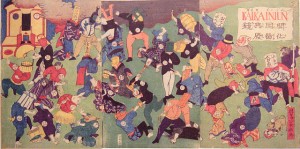By Pamela Toler (Regular Contributor)
In 1853 the United States government forced Japan to open its ports to United States merchants in a literal display of gunboat diplomacy. Commodore Perry’s act of military aggression against Japan is often given credit for dragging Japan into the nineteenth century. In fact, the real credit for Japan’s transformation belongs to the generation of Japanese elites who orchestrated the political and cultural revolution known as the Meiji Restoration.
Under the leadership of the Tokugawa shogunate, Japan had chosen to shut itself off from Western influence in the early seventeenth century. By the mid-eighteenth century, Japanese suspicion of all things Western had begun to fray around the edges, at least among the intellectual elite. A handful of Japanese scholars shifted their focus from Chinese culture to so-called “Dutch learning”.*
In the early nineteenth century, motivated by domestic problems and the threat embodied in Perry’s “black ships of evil mien”, reform-minded daimyo** began to mutter against the power of the shogunate, agitate for a restoration of imperial power, and call for the adoption of western learning and technology, particularly Western military technology. (We are, after all, talking about members of the samurai class, who were defined by their role as warriors.) In the years after Perry “opened” Japan,*** muttering turned to civil war.
In January, 1868, after two years of war, reformist (or perhaps more accurately, anti-Shogun) troops occupied Edo Castle, abolished the shogunate and proclaimed the “restoration” of the fifteen year old emperor, known by the reign name of Meiji. The Meiji Restoration, which lasted until 1912, was a period of self-conscious modernization and westernization–a focused leap across more than 200 years of technical innovation and social revolution in a period of forty some years. Members of the Japanese elite were sent to Europe and the United States to learn about Western government, western industry, and western culture. The reforms that followed transformed the government, the economy, land ownership, education, and the military. Much of Japan’s traditional life style was swept away, leaving in its place a new enthusiasm for western ideas on the part of urban intellectuals, a newly reconstructed vernacular literary language, and a new philosophy of individualism.
The abolition of the samurai as a warrior class was perhaps not the most important of the changes in practical terms but it was the clearest symbol of the decision to move from the medieval to the modern world.The samurai class was officially abolished in a series of measures that began in 1871, when all samurais were required to cut off their topknots, and ended with the Haittorei Edict of March 1876, which took away the samurais’ right to carry swords.
Many samurai found new ways to serve Japan in the reformed government. Others found themselves with neither purpose nor livelihood. The last gasp of the samurai came in 1877. Saigo Takamori, sometimes known as the Last Samurai led a hopeless rebellion against the Japanese government. Six hundred samurai, armed with the traditional sword and bow, fought the government’s newly trained modern army in an effort to reverse the westernizing changes that threatened their entire way of life. Many of the rebels believed it was better to die using the traditional weapons of the samurai than to live using modern ones–not surprisingly, they did.
With the samurai no longer a force, Japan built the modern army that would be a force to be reckoned with in the twentieth century.
*During the medieval period, Europeans in the Middle East were collectively known as Franks, after the Germanic tribes that ruled much of Europe. Similarly, “Dutch” was shorthand for all things Western in Japan because the only foreigners allowed to have direct contact with Japan were merchants from the Dutch East India Company (VOC). (You couldn’t describe Dutch interaction with Japan as close–the merchants were confined to the closely guarded island of Dejima in Nagasaki harbor and VOC ships were allowed to dock once a year. The Iron Curtain looked like it was made from fishing net by comparison.)
**The feudal lords of shogunate Japan

